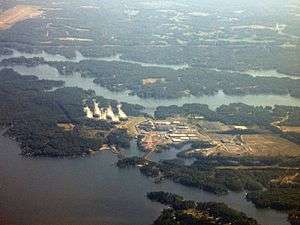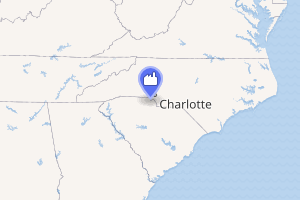Catawba Nuclear Station
The Catawba Nuclear Station is a nuclear power plant located on a 391-acre (158 ha) peninsula, called "Concord Peninsula", that reaches out into Lake Wylie, in York, South Carolina, USA. Catawba utilizes a pair of Westinghouse four-loop pressurized water reactors.[4]
| Catawba Nuclear Station | |
|---|---|
 | |

| |
| Country | United States |
| Location | York, York County, South Carolina |
| Coordinates | 35°3.1′N 81°4.2′W |
| Status | Operational |
| Construction began | May 1, 1974 |
| Commission date | Unit 1: June 29, 1985 Unit 2: August 19, 1986 |
| Construction cost | $6.594 billion USD (2007)[1] |
| Operator(s) | Duke Energy |
| Nuclear power station | |
| Reactor type | PWR |
| Reactor supplier | Westinghouse |
| Cooling towers | 6 × Mechanical draft |
| Cooling source | Catawba River |
| Thermal capacity | Unit 1: 3469 MWth[2] Unit 2: 3411 MWth[3] |
| Power generation | |
| Units operational | 2 × 1155 MW |
| Make and model | WH 4-loop (ICECND) |
| Nameplate capacity | 2310 MW |
| Capacity factor | 97.98% (2017) 86.35% (lifetime) |
| Annual net output | 19,707 GWh (2017) |
| External links | |
| Website | www |
| Commons | Related media on Commons |
As a part of the Megatons to Megawatts Program Catawba was one of the plants that received and tested 4 fuel assemblies containing MOX fuel with the plutonium supplied from old weapons programs.[5] Because concerns of nuclear proliferation are greater with fuel containing plutonium, special precautions and added security were used around the new fuel. The four test assemblies did not perform as expected and at present those plans are shelved.[6]
History
In 2005, Catawba Nuclear Station's Unit 1 was selected to test four fuel assemblies containing mixed oxide (MOX) fuel, incorporating 140 kg of plutonium supplied from recycled nuclear weapons material. The MOX fuel pellets were supplied by the Cadarache reprocessing facilitiy, and placed into fuel assemblies at the Melox facility, both in France. This test was part of the "Megatons to Megawatts" program, which was part of the Plutonium Management and Disposition Agreement between the United States and Russia.[5]
Plant design
The Catawba Nuclear Station uses ice condensers as part of its emergency containment systems. A nuclear plant ice condenser is a passive, static heat sink that relies on large quantities of ice to mitigate severe accidents. Ice condensers are designed to limit pressure in the event of an accidental steam release. This design allows smaller containment structures and reduced material requirements.[7]
Ownership
- Unit 1:
- Operator: Duke Power
- Owners: Duke Energy Carolinas, LLC 19.25%; North Carolina Municipal Power Agency 37.50%; North Carolina Electric Member Corporation 30.75%[8]
- Unit 2:
Surrounding population
The Nuclear Regulatory Commission (NRC) defines two emergency planning zones around nuclear power plants: a plume exposure pathway zone with a radius of 10 miles (16 km), concerned primarily with exposure to, and inhalation of, airborne radioactive contamination, and an ingestion pathway zone of about 50 miles (80 km), concerned primarily with ingestion of food and liquid contaminated by radioactivity.[10]
The 2010 population within 10 miles (16 km) of Catawba was 213,407, an increase of 53.3 percent in a decade, according to an analysis of the 2010 United States Census. The 2010 population within 50 miles (80 km) was 2,559,394, an increase of 25.0 percent since 2000. Cities within 50 miles include Charlotte, North Carolina (35 miles to city center).[11]
Seismic risk
In 2010, the NRC estimated the risk each year of an earthquake intense enough to cause core damage to the reactor at Catawba was 1 in 27,027.[12]
Incidents
15 May 2013
More than 100 gallons of water contaminated with radioactive tritium was released. However, the levels of tritium were less than one half the EPA limit for tritium and the leak was contained before it reached ground water.[13]
18 July 2017
After a 1-month standard inspection, the Nuclear Regulatory Commission (NRC) found that Catawba Nuclear Station staff had failed to take preventive maintenance measures after an electrical component in one of the emergency diesel generators had failed a routine inspection test. As a result, the NRC increased oversight of the plant until the issue was corrected. This incident was concluded to be of low to moderate safety significance.[14]
References
- "EIA - State Nuclear Profiles". EIA. Retrieved 3 October 2017.
- "Catawba Nuclear Station, Unit 1". NRC. Retrieved 5 November 2018.
- "Catawba Nuclear Station, Unit 2". NRC. Retrieved 5 November 2018.
- "Catawba Nuclear Station". South Carolina Nuclear Profile. U.S. Energy Information Administration. Retrieved 8 April 2011.
- "Military Warheads as a Source of Nuclear Fuel". World Nuclear Association. Retrieved 8 April 2011.
- Pavey, Rob (17 November 2009). "Duke Energy won't do more MOX tests". The Augusta Chronicle. Retrieved 11 April 2011.
- https://www.powermag.com/maintaining-nuclear-plant-ice-condensers-a-cool-responsibility/
- www.eia.gov. Retrieved 1 April 2017.
- "Overview". Archived from the original on 1 April 2017. Retrieved 1 April 2017., PMPA. Retrieved 1 April 2017.
- "Backgrounder on Emergency Preparedness at Nuclear Power Plants". Archived from the original on 2 October 2006. Retrieved 17 August 2012.
- Bill Dedman, "Nuclear neighbors: Population rises near US reactors", NBC News, 14 April 2011. Retrieved 1 May 2011.
- Bill Dedman, "What are the odds? US nuke plants ranked by quake risk", NBC News, 17 March 2011.
- "Memorandum about seismic hazard estimates" Archived 25 May 2017 at the Wayback Machine (PDF, 2 September 2010) - Dyches, Chris (2013). "Emergency Manager: No reason for concern after radioactive leak at nuclear station". WBTV. Retrieved 8 January 2018.
- Henderson, Bruce (18 October 2017). "Catawba nuclear plant on Lake Wylie to get extra federal oversight". The Charlotte Observer. Retrieved 4 December 2018.
- "CATAWBA NUCLEAR STATION - NRC INSPECTION REPORT 05000414/2017012 AND PRELIMINARY WHITE FINDING" (PDF). NRC. 22 August 2017. Retrieved 4 December 2018.
External links
- "Catawba 1 Pressurized Water Reactor". Operating Nuclear Power Reactors. U.S. Nuclear Regulatory Commission (NRC). 14 February 2008. Retrieved 15 November 2008.
- "Catawba 2 Pressurized Water Reactor". Operating Nuclear Power Reactors. NRC. February 14, 2008. Retrieved 15 November 2008.